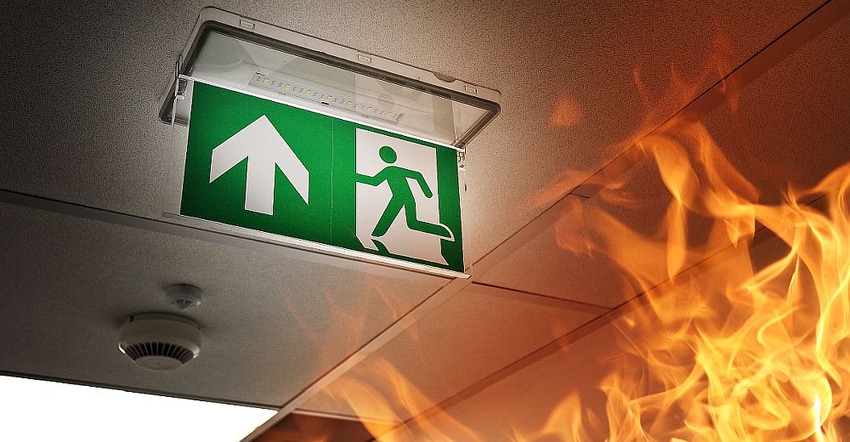A fire can be devastating to a self-storage business. Read about property issues that can increase fire risk and preventive tips to increase site safety.
September 1, 2020

Though self-storage operators should follow many of the same fire-safety principles at their facilities as those used to protect other building types, the nature of the business makes attention to prevention incredibly urgent. Consider the fire that occurred at a Shurgard Self Storage facility in Croydon, England, early last year. This disaster destroyed every item stored at the property, spanning 1,000 units. Losses included irreplaceable personal belongings as well as inventory used by small businesses.
It was undoubtedly a catastrophic loss, but it might have been prevented or mitigated with better policies and procedures. Below, I’ll give you some tips for approaching fire safety and prevention at your own location. First, let’s look at some common reasons fire occurs at self-storage facilities.
Causes of Fire
A self-storage fire can be caused by improperly stored flammable goods or packaging, though the biggest issues related to fire are the following:
Overcrowded units: Though it may make financial sense for tenants to rent the smallest space possible, units that are overpacked with boxes and other goods, compounded across an entire facility, are a huge fire risk.
Poor or no extinguishing systems: A fire-extinguishing system, such as sprinkler, can stop a fire from spreading or getting out of control. But if it’s poorly installed or configured, or covers too small of an area, it may be inadequate to mitigate an incident or seriously tackle a blaze.
Insufficient water supply: Some properties may have low water pressure, which could be inadequate for your own fire-suppression systems as well as those of the local fire department.
Inadequate detection: If there’s no one around to spot a fire, an automated detection and alert system in essential to notifying the fire department. Without such a system, serious damage is likely to occur before authorities are even aware of an incident.
Human acts: Two of the biggest causes of fires in self-storage facilities are human error and arson. Examples of human error include smoking near flammable objects, faulty installation of electrical equipment, improperly stored items, and storing prohibited/flammable items inside units. Sadly, there are also a number of deliberate crimes that are designed to destroy property.
Preventive Measures
As you can see, self-storage fires can be caused in a variety of ways. Thankfully, there are preventive solutions you can deploy based on your building type and the kinds of goods stored. To begin, you may need a class-A and -B fire extinguisher as well as sprinklers. A sprinkler system is particularly important because it can reduce fire, smoke and water damage, since it’ll use far less water than responding firefighters.
Here are some simple steps to establish good fire safety at your property. It’s particularly important to ensure staff members are trained and informed, safety equipment is available and in working order, and protection routines and strategies are in place.
Conduct a fire-risk assessment to evaluate the construction and layout of your structures. This can identify any inherent risks as well as any paths through which smoke and fire may spread. The most effective risk assessments don’t have a start or end point; rather, they continue throughout a property’s lifecycle.
Continually review and upgrade your fire-extinguishing and suppression devices. Check exit signage and alarms to ensure they’re up to scratch. Faulty equipment or unclear signage can be fatal.
Ensure facility managers are fully trained and safety routines are up to date. Staff should be aware of potential fire risks and how to identify them, so training and retraining is key.
Have policies regarding vehicle parking. For instance, vehicles shouldn’t be parked immediately adjacent to buildings because they can burst into flames or leak flammable material.
Fire-detection and -protection equipment should be positioned so it doesn’t impede the movement of people or the transfer of goods to and from storage units. Loaded trollies, for example, have been known to smash break-glass, fire-alarm call points.
Ensure video cameras, perimeter barriers and lighting are checked regularly and updated to work as effectively as possible.
Institute rigorous ID checks and access protocols. Common motives for arson are domestic disputes and conflicting ownership claims.
As you can see, prevention hinges on staff and customer education and training. Since many self-storage fires are caused by human error or arson, ensuring employees and tenants are aware of rules and responsibilities goes a long way toward increasing fire safety. Tenants should also be made aware that they need to insure their stored belongings.
The cause of the Shurgard fire, which occurred on Jan. 1, 2019, has yet to be determined. Self-storage operators should be prepared to face any fire threat, accidental or deliberate. Following these safety tips won’t only protect your facilities against fire, it’ll help you identify potential risks as they arise.
Olaf Jensen is the copywriter for U.K.-based fire-safety event FIREX International and its co-located shows, as well as IFSEC Global, a provider of news, features, videos and whitepapers for the security and fire industry. A graduate of the University of York, Olaf writes blogs, articles and editorials on fire-safety issues. For more information, visit www.firex.co.uk.
About the Author(s)
You May Also Like





